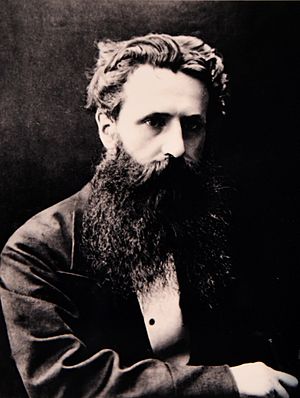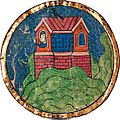Noah facts for kids
Noah is an important person in many religions, like Christianity, Judaism, and Islam. His name means 'rest' or 'comfort'. He was the son of Lamech and had three sons: Shem, Ham, and Japheth. The story of Noah and his famous boat, the Ark, is told in the Book of Genesis in the Bible. The Bible also says Noah was the first person to plant a vineyard (a place where grapes grow).

Contents
The Ark
The Book of Genesis tells us that Noah and his family believed in God when many others did not. Because of this, God told Noah that a great flood would cover the whole world to wash away evil. God instructed Noah to build a very large boat called an ark.
Noah was told to bring his family onto the ark. He also had to bring two of every kind of animal – one male and one female. At first, people made fun of Noah for building such a big boat. But when the flood came, only Noah, his family, and the animals on the ark were safe.
Noah and his family stayed on the ark until the water went down. To find dry land, Noah sent out a dove. The dove returned with an olive branch, showing that land was near. After the flood, God made a rainbow as a promise. This rainbow was a sign that God would never again destroy the Earth with a flood. Once the land was dry, the animals were released to live on Earth again.
Noah lived for 350 years after the flood. He died at the age of 950. The Bible says that after Noah, people did not live as long as they used to.
Flood Stories Around the World
Many cultures around the world have ancient stories about a great flood. These stories are often similar to Noah's story.
Mesopotamian Flood Stories

The story of Noah is very similar to an older flood story from Mesopotamia. This story is found in the Epic of Gilgamesh, written around 1800 BCE. In the Gilgamesh story, the gods decide to send a huge flood to destroy humans.
There are many similarities between Noah's story and the Gilgamesh story. Both include a great flood, building an ark, saving animals, and sending out birds after the flood. These similarities make many people believe that Noah's story was inspired by the Mesopotamian tales. The main differences are how long the flood lasted and the names of the mountains where the boats landed.
The oldest written flood stories come from Mesopotamia. These are found in texts like the Epic of Atrahasis and the Epic of Gilgamesh. The real-life king Gilgamesh is thought to have lived around 2700 BC.
Ancient Greek Flood Stories
Noah's story is also compared to the Greek myth of Deucalion. Deucalion was the son of Prometheus and Pronoia. Like Noah, Deucalion was warned about a flood, this time by the gods Zeus and Poseidon. He built an ark and put creatures on it. After his journey, he thanked the gods and received advice on how to bring people back to Earth.
Deucalion also sent a pigeon to check the world, and it returned with an olive branch. In some versions of the myth, Deucalion also invented wine, just like Noah. Some ancient writers, like Josephus, even used Deucalion's story as proof that a great flood really happened and that Noah existed.
Images for kids
-
Noah curses Ham by Gustave Doré
See also
 In Spanish: Noé para niños
In Spanish: Noé para niños








